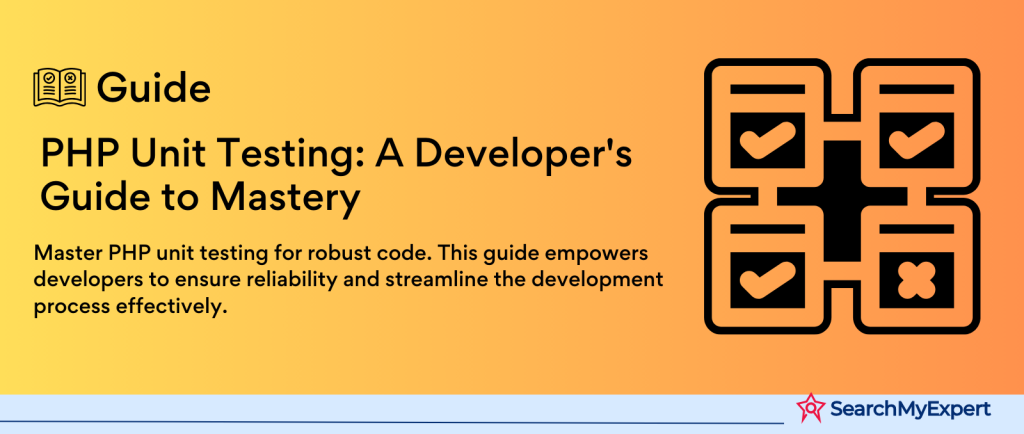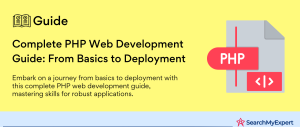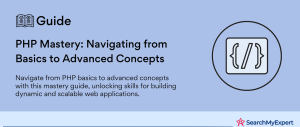Unit Testing: The Essential Guide for PHP Developers
What is Unit Testing?
Unit testing, a fundamental practice in software development, is all about verifying the smallest testable parts of an application, called units. These units are typically individual functions or methods within a class. In PHP, a dynamic language popular for web development, unit testing ensures that each component functions correctly in isolation.
Why Unit Testing Matters in PHP
- Isolates Code:
Pinpoints exactly where a problem exists, saving debugging time. - Ensures Code Quality:
Regular testing during development maintains high standards. - Facilitates Refactoring: Safely alter code, knowing tests will catch errors.
- Documents Code Behavior: Acts as a reference for how each unit is supposed to work.
Benefits of Unit Testing in PHP
- Improved Code Quality:
Catching bugs early means cleaner, more reliable code. - Efficient Debugging:
Quickly identify where things go wrong. - Enhanced Developer Productivity: Spend less time fixing bugs, and more time creating.
- Better Design Decisions: Encourages writing modular, maintainable code.
- Simplified Integration:
Testing components individually makes integration smoother.
For PHP developers, utilizing tools like PHPUnit, a programmer-oriented testing framework, can vastly streamline the unit testing process. Learn more about PHPUnit.
Types of Unit Tests: Understanding the Landscape
- Unit Tests:
Focuses on individual units of code. - Integration Tests:
Examines how different units work together. - End-to-End (E2E) Tests:
Tests the entire application in a setup that mimics real-world use.
While unit tests handle small components, integration tests verify the interaction between those components, and E2E tests check the entire application’s flow.
Unit Tests vs. Integration Tests vs. E2E in PHP
- Unit Tests: Fast,
isolated; best for algorithm validation. - Integration Tests: Slower; great for checking module interactions.
- E2E Tests: Slowest; ideal for testing user flows.
In PHP, balancing these tests is crucial. While unit tests are quicker and more isolated, integration and E2E tests provide a broader safety net.
Setting Up for Unit Testing in PHP: A Practical Guide
Installing PHPUnit (and Composer)
Getting started with unit testing in PHP requires setting up the right tools. PHPUnit, the go-to framework for PHP unit testing, works hand-in-hand with Composer, a dependency manager for PHP.
Step-by-Step Installation
- Install Composer:
Begin by downloading and installing Composer. - Add PHPUnit: Use Composer to install PHPUnit. Run composer require –dev phpunit/phpunit.
- Verify Installation:
Confirm with vendor/bin/phpunit –version.
PHPUnit’s compatibility with Composer simplifies managing dependencies and ensures you’re working with the latest version.
Creating Test Directories and File Naming Conventions
Organizing your tests is crucial for maintainability and efficiency.
Best Practices
- Directory Structure:
Create a tests directory in your project root. - Subdirectories:
Mirror your project’s structure inside tests. - Naming Conventions: Name test files like ClassNameTest.php.
This setup ensures clarity and helps developers quickly locate corresponding tests.
Understanding PHPUnit Annotations
PHPUnit uses annotations, and special comments in the code, to provide metadata about tests.
Key Annotations
- @test: Marks a method as a test.
- @dataProvider: Supplies data for a test method.
- @depends:
Indicates test dependencies. - @group:
Groups tests for selective running.
Annotations offer flexibility, allowing for more readable and organized tests.
Writing Your First Unit Test in PHP: Unlocking the Basics
Grasping Test Case Structure and Syntax
Diving into your first PHP unit test? It’s simpler than it seems! PHPUnit, a cornerstone for PHP testing, guides you through a structured approach.
Key Elements:
- Class Extension:
Your test class should extend PHPUnit\Framework\TestCase. - Test Methods: Each function, typically starting with test, represents an individual test.
Remember, clarity in naming and structure is your ally!
Assertions: The Heart of Unit Testing
Assertions are the checkpoints of your test, where you verify if things are on track.
Must-Know Assertions:
- Equality Checks:
Confirm if two values match. - Boolean Verifications: Ensure conditions return true or false.
- Count Assessments:
Count elements in an array.
Each assertion is a step towards confirming your code’s reliability.
Tackling Basic Data Types and Functions
Begin with the basics. Test strings, arrays, and boolean operations. This approach not only eases you into testing concepts but also builds a solid foundation.
Starting Points:
- String Operations:
Is your function returning the right text? - Array Handling: Are array elements and structures as expected?
- Boolean Logic:
Does your logic hold up under scrutiny?
Starting small, you’ll soon be testing with confidence!
Advanced Unit Testing Techniques in PHP
Mocking and Stubbing Dependencies
When testing in PHP, sometimes you need to simulate certain behaviors. That’s where mocking and stubbing come in!
Mocking Essentials
- Purpose:
Replace real objects with mocks to simulate specific scenarios. - Use Case: Test how your class interacts with an external API or database.
Stubbing Basics
- Goal:
Create stubs, simpler versions of objects, to control responses. - Application:
Ensure consistency in tests by controlling external influences.
PHPUnit provides elegant solutions for both, enhancing your testing arsenal.
Data Providers for Parameterized Tests
Parameterized tests are a game-changer. They allow you to run the same test with different data sets.
Advantages of Data Providers
- Efficiency: Test multiple scenarios with a single test method.
- Clarity:
Keep your tests organized and readable.
With data providers, you streamline your testing process, making it both thorough and efficient.
Handling Exceptions and Edge Cases
Exception testing is crucial in ensuring your application’s robustness.
Testing Exceptions
- Method: Use PHPUnit’s built-in methods to expect exceptions.
- Purpose:
Ensure your application gracefully handles unexpected situations.
Edge cases, those rare or extreme conditions, also need attention.
Edge Case Considerations
- Focus: Test the boundaries of your code.
- Outcome: Uncover and fix potential bugs before they become issues.
In PHP, handling these scenarios thoughtfully ensures your code’s reliability in every situation.
Test-Driven Development (TDD) in PHP: A Revolutionary Approach
Writing Tests Before Code: The Red-Green-Refactor Cycle
TDD, a radical shift in development methodology, prioritizes tests before actual code.
The TDD Cycle:
- Red:
Write a failing test. - Green: Develop just enough code to pass the test.
- Refactor:
Clean up the code while maintaining functionality.
This cycle ensures every new feature begins with a test, embedding quality from the start.
Benefits of the TDD Approach
TDD isn’t just a technique; it’s a mindset shift with profound benefits.
Why TDD Wins:
- Enhanced Code Quality:
Regular testing minimizes bugs. - Better Design Decisions:
Encourages thinking before coding. - Ease of Refactoring: Safe to change code with a test safety net.
- Simplified Debugging: Bugs are caught early in the cycle.
In PHP, TDD can transform how you approach coding challenges, leading to cleaner, more reliable code.
Challenges of TDD
However, TDD isn’t without its hurdles.
TDD Pitfalls:
- Learning Curve: It requires time and effort to master.
- Initial Slowness: Writing tests first can feel slow.
- Complex Scenarios: TDD can be tricky with complex dependencies.
Despite these challenges, the long-term gains of TDD in PHP development are substantial.
Continuous Integration and Continuous Delivery (CI/CD) in PHP: Streamlining Your Workflow
Automating Test Execution with CI Tools
In the realm of modern development, CI tools are indispensable, automating the testing process and ensuring code integrity.
The Power of Automation
- Instant Feedback:
Get immediate results on code changes. - Consistency:
Ensure tests are run in a standardized environment. - Efficiency:
Save time and reduce manual errors.
Popular CI tools like Jenkins, Travis CI, and GitHub Actions seamlessly integrate with PHP projects, making automation a breeze.
Integrating Unit Tests into Your Development Workflow
Unit tests are not just a development phase but a continual process.
Integration Strategies
- Pre-Commit Checks:
Run tests before the code is committed. - Pull Request Validation: Ensure tests pass before merging.
- Automated Deployment: Only deploy after successful test runs.
Incorporating unit tests into your CI/CD pipeline in PHP not only prevents bugs but also fosters a culture of quality.
Best Practices and Resources for PHP Unit Testing
Maintainability and Readability of Test Code
The effectiveness of your tests heavily relies on their clarity and sustainability.
Key Practices for Better Test Code:
- Clear Naming:
Use descriptive names for test methods. - Small Tests:
Focus each test on a single behavior. - Avoid Magic Numbers: Use constants or variables for clarity.
- Documentation: Comment complex logic for future reference.
Well-structured tests are easier to maintain and understand.
Popular PHPUnit Plugins and Extensions
Enhance your testing with these powerful tools.
Must-Try Extensions:
- PHPUnit Coverage: For detailed code coverage reports.
- Mockery:
A flexible alternative for creating mock objects. - DBUnit:
Ideal for database interaction testing.
These tools integrate seamlessly with PHPUnit, enriching your testing capabilities in PHP.
Additional Learning Resources and Documentation
Continued learning is key to mastering unit testing.
Essential Resources:
- PHPUnit Manual:
The official guide to PHPUnit. - PHP Testing Handbook: A comprehensive resource for PHP testing strategies.
- Testing PHP Code:
A course for deep diving into PHP testing.
These resources provide invaluable insights and practical tips for effective PHP testing.
Conclusion
Unit testing in PHP is an essential skill that transforms good code into great code. From setting up PHPUnit to embracing Test-Driven Development and integrating CI/CD, each step enhances code quality and developer efficiency. Adopting best practices ensures your tests are maintainable and understandable. With the right tools and resources, PHP unit testing becomes not just a task, but a craft. As you continue your journey, remember that each test written is a step towards perfection in your development process. Embrace these techniques, and watch your PHP projects reach new heights of reliability and excellence.
Empower your web development with PHP Development Service Companies.
Table of Contents
Toggle






